
To specify a UTM grid zone, the zone number (column) is given before the zone letter (row), such as Zone 11U.Įach zone has a central meridian which extends north-south along the middle of the zone (3° from the east and west zone boundaries), splitting the zone into two equal halves. Letters A, B, Y and Z label polar regions in the UPS coordinate system. Note that letter N designates the first latitude band above the equator, so any letter of alphabet after N refers to a band in northern hemisphere and any letter before N refers to a band in southern hemisphere.

Letters I and O are omitted to prevent confusion with numbers one and zero. The 20 bands are labeled with letters, beginning with C and ending with X from south to north. UTM Zone - northern hemisphere © Wikimedia CommonsĮach zone is divided into horizontal bands 8° of latitude wide. Therefore Zone 1 lies between 180°W to 174°W longitude lines, Zone 2 is between 174°W and 168°W longitude lines, and Zone 60 lies between 174☎ and 180° (International Date Line) longitude lines. UTM zones are numbered from 1 to 60 starting from 180° longitude at the International Date Line and proceeding eastward. UTM grid zones on a projected map of the world © Wikimedia Commons UTM Zone As mentioned, choosing a secant projection and a narrow zone minimizes the distortions in a map generated from UTM projection. As a result of preserving angles and shapes, area or size of features are distorted in these maps. In a conformal projection local angles are preserved and shapes are represented accurately and without distortion for small areas. The Mercator and Transverse Mercator projections are conformal projections. Naturally for areas that span more than one UTM zone, the distortion and error increase. The scale error within each UTM projection zone remains less than 0.1 percent, or in other words scale distortion is kept to less than 1 part in 1000. At places on map where the cylinder is outside the globe, features appear larger than in reality and scale factor is greater than 1.

The central meridian has a scale factor of 0.9996. Between the secant lines, where the cylinder is inside the globe, features appear smaller than in reality and scale factor is less than 1. The scale is true (scale factor = 1) on each of the standard meridians meaning that there is no distortion along these lines.

Also a map derived from a secant cylinder has less overall distortion than a map from a tangent cylinder. The narrow width (6° of longitude) of each zone ensures minimal scale distortion within a zone. Polar regions (below 80°S and above 84°N) use the UPS - Universal Polar Stereographic coordinate system based on the Polar Stereographic projection. Also since a Transverse Mercator projection results in extreme distortion in polar areas, the UTM zones are limited to 80°S and 84°N latitudes.

The cylinder is secant in the UTM projection it intersects the globe creating two standard meridians that are 180 km to each side of the central meridian. The meridian at the center of each zone is called the central meridian. In such a projection, instead of projecting the complete globe into a flat surface, each of the 60 strips or zones gets projected onto a plane separately, therefore minimizing scale distortion within each zone. In the UTM projection the transverse cylinder rotates by 6° increments, thus creating 60 (360° / 6°) strips or projection zones. The cylinder in the Transverse Mercator projection is tangent along a meridian (line of longitude) or it is secant, in which case it cuts through the earth at two standard meridians. Home > Education > UTM - Universal Transverse Mercator UTM - Universal Transverse Mercator UTM ProjectionĪs the name suggests, the Universal Transverse Mercator projection is based on the cylindrical Transverse Mercator projection.


 0 kommentar(er)
0 kommentar(er)
